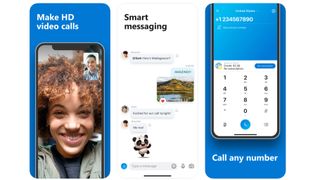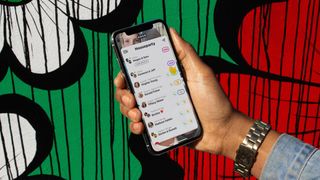Best chat apps: the top ways to video call your friends and family
Six great options

A great way of staying connected is with chat apps so you can video call or participate in group chats. They're useful platforms to replicate the feeling of seeing your friends and family face-to-face.
There are plenty of video calling and apps on computers, smartphones and computers - perhaps too much, as it can be hard to make sure all your friends are on the same one, and not using a dodgy app.
To solve that, we've compiled this list of some of the best chat apps, that work for both text conversations and video or audio calls. The ones we've highlighted are ones we use, both when we're testing gadgets and for personal use, so we can recommend them as safe and easy-to-use.
This way you can share a cozy Sunday, an intimate conversation or a massive group hangout, even if you can't physically see the person or people you want to.
Skype
Why you can trust TechRadar

Download: iOS / Android / Desktop
Skype is one of the most obvious video calling options and also one of the ones that has been around the longest. It runs on pretty much every platform under the sun, including Android and iPhone handsets, tablets, Windows and Mac PCs, and even Xbox One, so just about everyone you want to talk to should have access one way or another.
It also supports up to 24 video call participants at once, which is more people than you could comfortably get in an average-sized living room, and voice calls and text chats are supported too, for when you’re rocking quarantine hair and don’t quite feel camera-ready.
- Here’s how to use Skype
Houseparty

Download: iOS / Android / Desktop
Houseparty is a relatively recent addition to the video chat brigade, but it has quickly become very popular, and with good reason. For one thing, it tries to make video calls as slick and seamless as possible, by alerting you as soon as a friend launches the app, so you know they’re ready to talk. It will do the same for them when you launch the app, and even turns your camera on.
There are also built-in games that you can play with your friends, so it goes beyond conversation. Though video calls on Houseparty only support up to eight participants, so it’s not ideal for big groups.
- New to the app? Here’s how to use Houseparty
FaceTime

Download: iOS
If you have an iPhone, iPad or Mac then you’re probably already familiar with FaceTime – and if you don’t then you can’t use it, which is its greatest weakness. Still, assuming you and your friends and family are ensconced in Apple’s ecosystem, it’s a great video calling choice.
The FaceTime app will already be on your iDevice, meaning you – and anyone else able to use FaceTime – has very little barrier to entry. You can have group video calls with up to 32 people at once, start calls direct from the Messages app, and add effects – including Animoji and Memoji. If you and those you’re communicating with are Apple users, then FaceTime is arguably the slickest, simplest option.
- Get started with our guide to using FaceTime
Google Duo

Download: iOS / Android / Desktop
Google Duo is almost as slick as FaceTime – it launches the camera as soon as you open the app, ensures video calls never take more than a few taps, and has handy features like ‘Knock Knock’, which lets you see the video stream of the person calling before you choose whether to answer.
Unlike FaceTime, this isn’t exclusive to certain hardware either. Google Duo works on Android of course, but it also works on iOS. However, you can only have up to 12 participants in a call, so it’s more restrictive than the likes of FaceTime and Skype on that front.
- Here’s how to use Google Duo

Download: iOS / Android / Desktop
You’re probably already using WhatsApp for text chats and maybe even for voice calls, but it’s also a great video chat platform, as long you only want to talk to up to three people at once, as four people per video call is the limit.
But WhatsApp excels in other areas, with a low data use mode (ideal if you’re eating up your allowance during lockdown), plus encrypted calls, making it more secure than some options, and desktop and web versions for when you don’t want to stare at your phone.
- Learn how to use WhatsApp
Facebook Messenger

Download: iOS / Android / Desktop
Facebook Messenger is another app that probably won’t need any introduction for most people, and while it puts text chat front and center, it also supports video chat. Calls can have up to eight people, and support face filters and other interactive features, and you can use Facebook Messenger across a range of platforms, including Android, iOS, and via a browser.
And because it’s tied to your Facebook account, if you have one of those you already have a Facebook Messenger account – but if you don’t and would rather not sign up for one, you can also sign up for Messenger separately on mobile.
Other options
One of the options above should suit your video calling needs, but if not there are plenty of other possible apps too.
Other strong options include Zoom, which supports up to 100 participants, though limits calls on free plans to 40 minutes. Then there’s Google Hangouts, which is Google’s business-focused alternative to Duo, but still very viable for friends and family.
There’s also Line, which is a lot like WhatsApp – putting a big focus on text and voice conversations but also allowing video calls. You can have up to 200 people on a call, though only four will be displayed on your screen at any given time.
- Need an app for work? Here's the best video conferencing software
Get daily insight, inspiration and deals in your inbox
Get the hottest deals available in your inbox plus news, reviews, opinion, analysis and more from the TechRadar team.
James is a freelance phones, tablets and wearables writer and sub-editor at TechRadar. He has a love for everything ‘smart’, from watches to lights, and can often be found arguing with AI assistants or drowning in the latest apps. James also contributes to 3G.co.uk, 4G.co.uk and 5G.co.uk and has written for T3, Digital Camera World, Clarity Media and others, with work on the web, in print and on TV.

